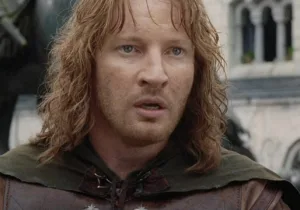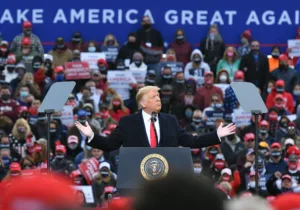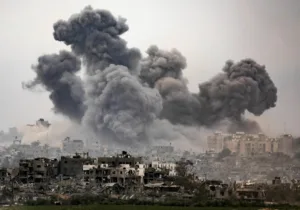Nigel Hamilton is well known for his three volume biography of Field Marshal Bernard Montgomery. But as this first volume of a planned multi-volume history on FDR’s war leadership reveals (volume II has already been published and will be reviewed here), he’s not necessarily the greatest admirer of Britain’s WWII leadership, including Winston Churchill. Instead he is an avid FDR fan, heaping praise on the President’s wartime leadership as prescient, wise and often lonely. American military leadership opposed Roosevelt’s vision for the first year of America’s war, including War Secretary Henry Stimson, Army Chief of Staff George Marshall, and Chief of Naval Operations Ernest King, all of whom favored a 1942 U.S. invasion of Europe over North Africa. They assumed FDR favored the latter only because he had been bewitched by Churchill.
In fact, FDR had eyed the wisdom of a North African campaign even before Pearl Harbor. He was more anxious for a European invasion than the British but sufficiently realistic to know American military prowess was not ready for a frontal assault on the Third Reich as the first major act of its entrance into the war. And unlike many at the soon to be completed Pentagon, Stalin, who was pressing for a Western front, immediately recognized FDR’s strategic shrewdness. Invading Morocco and Algeria would, he said, keep Spain neutral, bring France to the Allied side, and force Italy out of the war.
Meanwhile, as Hamilton recounts, FDR’s top military staff and war secretary kept grousing against North Africa almost to the point of insubordination, or “quasi-mutiny,” even suggesting a pivot towards the Pacific, contra FDR’s policy to prioritize defeating Germany. In early 1942 FDR was also managing Douglas MacArthur and the Philippines disaster. Hamilton portrays MacArthur, at least early in the war, as inept, leaving his planes exposed to Japanese attack and failing to move necessary food supplies to the fortress on Corregidor. These charges are common but somewhat unfair. The planes were aloft and on alert after Pearl Harbor, but the expected Japanese attack, due to weather, was delayed, arriving during a brief break with U.S. planes on the ground. And the Philippines government resisted the food shipments transfer to Corregidor, worried about starving Filipinos.
Hamilton also portrays MacArthur suffering a melt-down, sending intemperate cables and backing a plan by the Philippines president to cut loose from the U.S. and surrender autonomously to Japan. Under siege with his wife and child, MacArthur can be forgiven for a momentary lapse in probity. FDR, understanding his ongoing need for MacArthur, gently but firmly admonished the general and the Philippines to persevere, prompting Marshall to recall that he then realized FDR was a great man. Roosevelt of course knew the Japanese would prevail in the Philippines but a separate peace would do little to nothing to alleviate Filipino suffering, while surely dispiriting the overall Allied effort in the Pacific.
The Philippines had already been promised full independence by the U.S., and FDR contrasted robust Filipino resistance to the Japanese to more languid performances by Britain’s Indian troops. This comparison is, according to Hamilton, what partly prompted FDR’s pushing Churchill towards steps for Indian independence, which the prime minister naturally resented. Hamilton insists neither the Indians, nor even the British troops themselves, were very interested in sacrificing themselves for Britain’s Asian empire, which he thinks partly explains the quick collapse of Singapore against a numerically inferior Japanese force. (The Japanese were also outnumbered by the American/Filipinos in the Philippines.)
Churchill’s war-time leadership during the first two years was somewhat ineffectual militarily, Hamilton asserts. The prime minister’s oratory of course had roused the British people to resistance. And the Royal Air Force had prevented German air supremacy over Britain therefore negating any possibility of invasion. But otherwise British forces were everywhere defeated and in retreat, the Singapore and Tobruk surrenders ranking among the most humiliating in British military history. FDR helped salve Britain’s Tobruk disaster with expedited delivery of American tanks to remaining British forces in Africa, which would contribute to the eventual victory by Montgomery over Erwin Rommel at El Alamein.
In short, FDR is the unalloyed hero of Hamilton’s history. Roosevelt’s judgment and strategic vision surpassed Churchill, MacArthur, Marshall, Stimson, and King, among others. He craftily imposed his leadership on these large personalities, while retaining their respect and even admiration. No less egotistic than the others, FDR, unlike Churchill in particular, was a good listener, who absorbed other opinions, and who reflected deeply on his own, his paralysis almost a gift in this regard.
Hamilton’s version of history is appealing to American ears, especially to FDR fans, of whom I am one. It all rings largely true if somewhat incomplete. Churchill’s exertions in 1940 and 1941 to keep Britain afloat were obviously enormous, without which American entry into the war, effectively not until 1942, would have been perhaps irrelevant or at least too late. MacArthur and Marshall were heroes and geniuses in their own right whom FDR wisely deployed, which is also true for the aging but competent Stimson, and probably true for King.
Hamilton suggests FDR would choose Eisenhower over Marshall for the Normandy invasion in part because he never fully trusted and respected the latter after his resistance to North Africa. This suggestion is provocative and may carry some truth, although firm documentation seems lacking. As Hamilton notes, FDR, unlike Churchill, avoided putting much to paper. The explanation attributed to FDR, that he could not risk not having Marshall at his side in Washington, may have been partly public relations but also still largely valid.
Overall Hamilton’s account is insightful and highly enjoyable, pleasantly challenging some conventional WWII wisdom that merits debate. One small mistake stuck out to me. Hamilton oddly describes Lord Halifax, Churchill’s sometime pro-appeasement rival, later war-time ambassador to the U.S, as a devout Roman Catholic. Halifax famously and sometimes mystically adhered to the Church of England, although in its Anglo-Catholic wing. Hamilton has Halifax attending a supposed St. Thomas Catholic parish in Washington, D.C. Almost certainly he means St. Thomas Episcopal Church, which is at Dupont Circle near the British Embassy, and which FDR also attended.
Hamilton offers other incidental war-time details especially about Washington that are fascinating. For example, returning from Hyde Park together, Churchill and FDR dismounted from their train at a railroad siding in Arlington, near the present Pentagon, instead of in the city, presumably to avoid attention and congestion in the busy war-time city. Such details caffeinate Hamilton’s narrative and lend further credence to his main suppositions.







 Live in the DC area? Sign-up for Providence's in-person events list!
Live in the DC area? Sign-up for Providence's in-person events list!